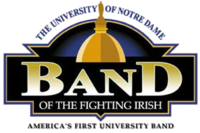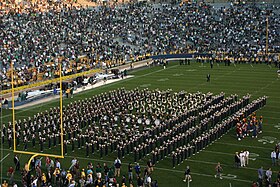
The University of Notre Dame du Lac, known simply as Notre Dame, is a private Catholic research university in Notre Dame, Indiana. Founded in 1842 by members of the clerical Congregation of Holy Cross, the main campus of 1,261 acres has a suburban setting and contains landmarks such as the Golden Dome, the Word of Life mural, Notre Dame Stadium, and the basilica.
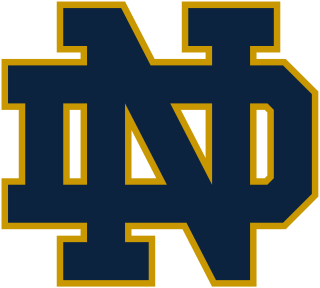
The Notre Dame Fighting Irish are the athletic teams that represent the University of Notre Dame. The Fighting Irish participate in 26 National Collegiate Athletic Association (NCAA) Division I intercollegiate sports and in the NCAA's Division I in all sports, with many teams competing in the Atlantic Coast Conference (ACC). Notre Dame is one of only 16 universities in the United States that play Division I FBS football and Division I men's ice hockey. The school colors are gold and blue and the mascot is the Leprechaun. It was founded on November 23, 1887, with football in Notre Dame, Indiana.

The Notre Dame Fighting Irish football team is the college football team representing the University of Notre Dame in Notre Dame, Indiana, north of the city of South Bend, Indiana. The team plays its home games at the campus's Notre Dame Stadium, which has a capacity of 77,622. Notre Dame is one of three schools that competes as an Independent at the National Collegiate Athletic Association (NCAA) Football Bowl Subdivision (FBS) level; however, they play five games a year against opponents from the Atlantic Coast Conference (ACC), of which Notre Dame is a member in all other sports except ice hockey.

Notre Dame Stadium is an outdoor football stadium in Notre Dame, Indiana, the home field of the University of Notre Dame Fighting Irish football team.
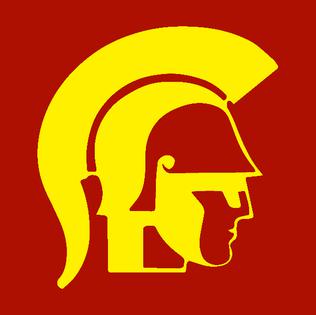
The USC Trojan Marching Band, also known as the Spirit of Troy and nicknamed The Greatest Marching Band in the History of the Universe, Ever (TGMBITHOTUE), represents the University of Southern California (USC) at various collegiate sports, broadcast, popular music recording, and national public appearance functions.

The Holy War is an American rivalry between the Boston College Eagles and University of Notre Dame Fighting Irish, a technical nonconference rivalry in college football, but in most sports an Atlantic Coast Conference rivalry. The series derives its name from the fact that the Eagles and the Fighting Irish represent the only two Catholic universities in the United States which still compete in the Football Bowl Subdivision of the National Collegiate Athletic Association, the highest level of competition in American college football.
The Notre Dame Victory March is the fight song for the University of Notre Dame.

The Michigan Marching Band is the official marching band of the University of Michigan. The band performs at all Michigan Wolverines football home games, select away games, and numerous concerts, pep rallies, and parades. A student musical ensemble, the MMB evolved from the original Michigan Band of twenty-two players in 1896 to today's band of over 400 members.

The Notre Dame–Purdue football rivalry is an American college football rivalry between the Notre Dame Fighting Irish football team of the University of Notre Dame and Purdue Boilermakers football of Purdue University.
The Irish Guard is a group of uniformed students that leads the University of Notre Dame's Band of the Fighting Irish onto the field at home games. They are considered by some to be one of the integral parts in the pageantry, lore, and legend of Notre Dame football.
Notre Dame Fighting Irish football rivalries refers to rivalries of the University of Notre Dame in the sport of college football. Because the Notre Dame Fighting Irish are independent of a football conference, they play a national schedule, which annually includes historic rivals University of Southern California and Navy, more recent rival Stanford, and five games with ACC teams.
The Sound of the Golden Hurricane is the school marching band for the University of Tulsa, based in Tulsa, Oklahoma. The band is currently under the direction of Mr. Matthew Schepers; overseen by the Director of Instrumental Ensembles, Mr. Richard Wagner. The band's colorguard is directed by Ms. Adrienne Gaddy. It specializes in performing a variety of music geared to crowd entertainment, and performs in a multitude of styles during TU athletic events. The band performs a different halftime show for almost every home game throughout each football season, and introduced a new pre-game routine in 2013. The Sound debuted new uniforms during the 2016 season, featuring the first new uniform design for the group since the early 1990s.

Brian Keith Kelly is an American college football coach. He is the head football coach at Louisiana State University (LSU), a position he has held since the 2022 season. Kelly served as the head football coach at Grand Valley State University from 1991 to 2003, Central Michigan University from 2004 to 2006, the University of Cincinnati from 2006 to 2009, and the University of Notre Dame from 2010 to 2021. He led the Grand Valley State Lakers to consecutive NCAA Division II Football Championships in 2002 and 2003. Kelly's 2012 Notre Dame team reached the 2013 BCS National Championship Game, while his 2018 and 2020 teams made appearances in the College Football Playoff.
The 1925 Rose Bowl was a college football bowl game. It was the 11th Rose Bowl Game. The Notre Dame Fighting Irish defeated Stanford University, 27–10. The game featured two legendary coaches, Knute Rockne of Notre Dame, and Pop Warner in his first year at Stanford. The game also featured the Four Horsemen of Notre Dame. Elmer Layden of Notre Dame and Ernie Nevers of Stanford were named the Rose Bowl Players Of The Game when the award was created in 1953 and selections were made retroactively.

The Notre Dame–USC football rivalry is an American college football rivalry between the Notre Dame Fighting Irish football team of the University of Notre Dame and USC Trojans football team of the University of Southern California, customarily played on the Saturday following Thanksgiving Day when the game is in Los Angeles or on the second or third Saturday of October when the game is in South Bend, Indiana.
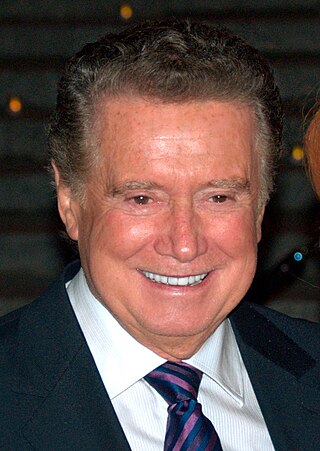
Regis Francis Xavier Philbin was an American television presenter, talk show host, game show host, comedian, actor, and singer. Once called "the hardest-working man in show business", he held the Guinness World Record for the most hours spent on US television.
The 1973 Notre Dame Fighting Irish football team represented the University of Notre Dame during the 1973 NCAA Division I football season. The Irish, coached by Ara Parseghian, ended the season undefeated with 11 wins and no losses, winning the national championship. The Fighting Irish won the title by defeating the previously unbeaten and No. 1 ranked Alabama Crimson Tide in the 1973 Sugar Bowl by a score of a 24–23. The 1973 squad became the ninth Irish team to win the national title and the second under Parseghian. Although Notre Dame finished No. 1 in the AP Poll to claim the AP national title, they were not awarded the Coaches title, since Alabama was awarded the Coaches Poll title before the bowl season.

The Notre Dame–Stanford football rivalry is an American college football rivalry between the Notre Dame Fighting Irish football team of the University of Notre Dame and Stanford Cardinal football team of Stanford University. As of 2023, the Notre Dame Fighting Irish and Stanford Cardinal have met 37 times, beginning in 1925. The Notre Dame–Stanford game has been played annually since 1997, with the teams meeting at Notre Dame Stadium earlier in the season in even-numbered years, and at Stanford Stadium on the weekend following Thanksgiving in odd-numbered years since 1999. The game typically alternates positions in Notre Dame's schedule with its other former Pac-12 opponent, USC.

Sam Palumbo is a former linebacker in the National Football League (NFL). He was drafted by the Cleveland Browns in the fourth round of the 1955 NFL draft and played two seasons with the team. During the 1957 NFL season he played with the Green Bay Packers and later was a member of the Buffalo Bills of the American Football League (AFL).
The 2013 Pinstripe Bowl was an American college football bowl game that was played on December 28, 2013, at Yankee Stadium in the New York City borough of The Bronx. It was one of the 2013–14 bowl games that concluded the 2013 FBS football season. The fourth edition of the Pinstripe Bowl, it featured the Rutgers Scarlet Knights of the American Athletic Conference against the Notre Dame Fighting Irish, an independent team. It began at 12:00 noon EST and aired on ESPN. The game was sponsored by the New Era Cap Company, and was officially known as the New Era Pinstripe Bowl.
